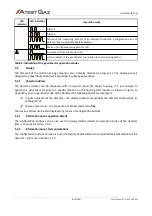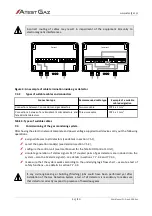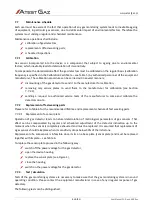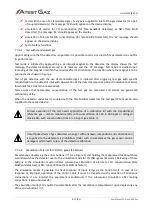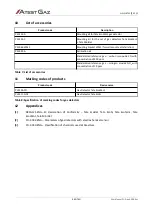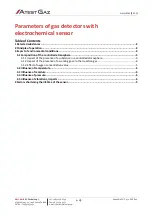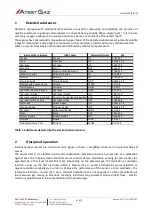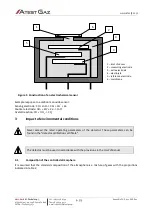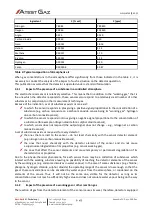
www.atestgaz.pl
1
Detected substances
Detectors equipped with electrochemical sensors are used for measuring and detecting the presence of
specific substances in gaseous atmospheres in concentrations generally above single "ppm," but in some
cases (e.g. oxygen, hydrogen), the concentration may be tens or hundreds of thousands "ppm".
These gases have characteristic measurement ranges. Most of the detected substances are primarily volatile
inorganic compounds. Some organic compounds, such as ethylene, ethylene oxide, may also be detected.
Table 1 presents an example list of substances detected by electrochemical sensors.
2
Principle of operation
Electrochemical sensors are micro fuel cells. Figure 1 shows a simplified structure of an electrochemical
sensor.
The sensor inlet (1) is protected with anti-condensation membrane (6) which serves also as a protection
against dust. The simplest electrochemical sensor consists of two electrodes: sensing (2) and counter (3),
separated by a thin layer of electrolyte (4). Depending on the detected gas, the reduction or oxidation
reaction occurs on the first electrode, which is balanced by a counter electrode by water oxidation or
oxygen reduction respectively. In order to improve the performance of the sensor, a third electrode – the
reference electrode – is used (5). It has a constant potential that is not dependent on the concentration of
the measured gas. Owing to electrode reactions, electrons are generated, whose orderly flow – electric
current, is proportional to the concentration of the detected gas.
Atest-Gaz
A. M. Pachole sp. j.
ul. Spokojna 3, 44-109 Gliwice, Poland
VAT No.: PL 9691433231
tel.: +48 32 238 87 94
fax: +48 32 234 92 71
e-mail: contact@atestgaz.pl
p. 2/5
Appendix: PU-Z-032-ENG R02
•
Table 1: Substances detected by the electrochemical sensors
Name of the substance
IUPAC name
Molecular formula
CAS
Oxygen
Oxygen
O2
7782-44-7
Ozon
Trioxygen
O3
10028-15-6
Hydrogen
Hydrgen
H2
1333-74-0
Ammonia
Azane
NH3
7664-41-7
Arsine
Arsenic trihydride, Arsane
AsH3
7784-42-1
Carbon monoxide
Carbon monoxide
CO
630-08-0
Chlorine
Chlorine
Cl2
7782-50-5
Chlorine dioxide
Chlorine dioxide
ClO2
10049-04-4
Ethylene oxide, epoxyethane
Oxirane
C2H4O
75-21-8
Formaldehyde
Methanal
HCHO
50-00-0
Hydrazine, diamine, diazane
Hydrazine
N2H4
302-01-2
Hydrogen chloride
Hydrogen chloride
HCl
7647-01-0
Hydrogen cyanide, Prussic acid
Formonitrile, Hydridonitridocarbon HCN
74-90-8
Hydrogen sulfide, Sulfane
Hydrogen sulfide
H2S
7783-06-4
Nitric oxide
Oxidonitrogen
NO
10102-43-9
Nitrogen dioxide
Nitrogen dioxide
NO2
10102-44-0
Phosgene
Carbonyl dichloride
COCl2
75-44-5
Silane
Silane
SiH4
7803-62-5
Sulphur dioxide
Sulphur dioxide
SO2
7446-09-5
Ethylene
Ethene
C2H4
74-85-1
Tetrahydrotiofene (THT)
Thiolane
C4H8S
110-01-0


